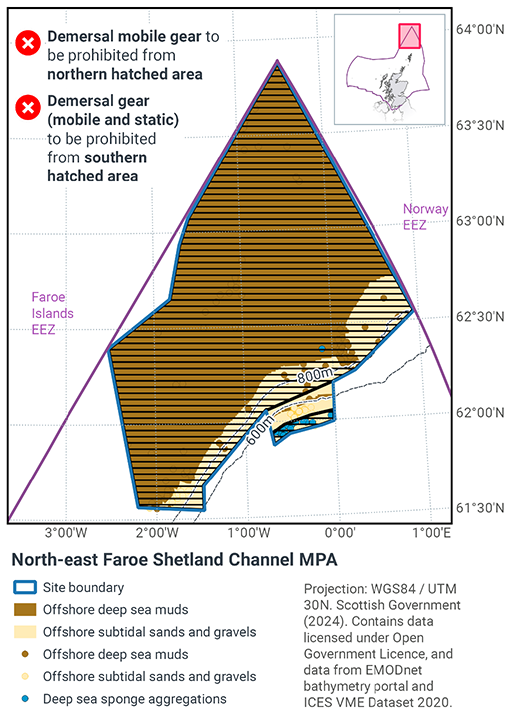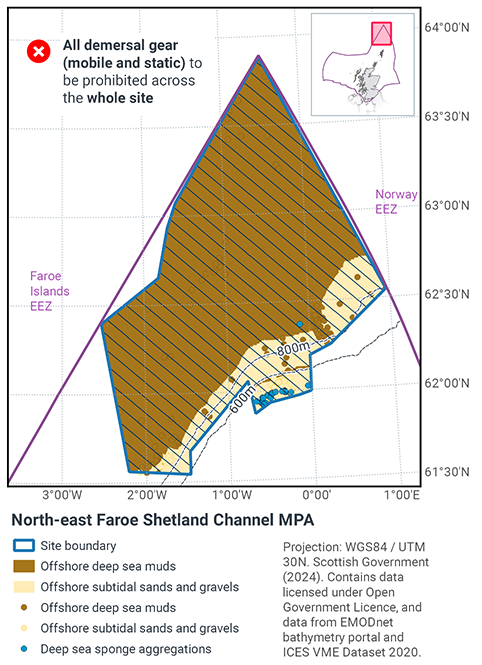Draft Fisheries Assessment – North-East Faroe-Shetland Channel NCMPA: Fisheries management measures within Scottish Offshore Marine Protected Areas (MPAs)
These assessments look at the fishing activity occurring within each offshore MPA and SAC and assess the potential impacts of this activity on the protected features within each site. This assessment is for North-East Faroe-Shetland Channel NCMPA
5. Management Options
5.1 Overview of management options
Management measures are being considered by Scottish Ministers and any decision as to which measures ought to be taken forward will follow upon a statutory public consultation exercise. Any such decision will also be taken in line with the Scottish Ministers obligations in relation to the exercise of their functions.
The socioeconomic impacts and costs of each management option (no additional management, zoned management, and full site exclusion) have been assessed within the Socio-Economic Impact Assessment (SEIA) and Sustainability Appraisal (SA) and are not discussed within this fisheries assessment. Nor are other considerations, statutory and non-statutory, which the Scottish Ministers may be required to take into account when assessing whether the imposition of a particular measure is appropriate.
This section assesses the suitability of the management options solely in light of the conservation objectives, biological characteristics of protected features, and current activity levels for North-East Faroe-Shetland Channel NCMPA.
5.2 Assessment of management options
5.2.1 No additional management
The assessment identified that management measures would be required to avoid hindering the achievement of the conservation objectives from mobile demersal gear (demersal trawls) for the site. Thus, the option of no management is not considered further.
5.2.2 Zoned management
Zoned fisheries management measures (Figure 4.) would be introduced to reduce/limit pressures. This would involve:
- the exclusion of demersal mobile gears for the majority of the site and
- the exclusion of all demersal mobile and demersal static gears for the entirety of the site where deep-sea sponge aggregations are known to occur. This is considered due to the sensitivity of the feature.
Deep-sea sponge aggregations are considered to be a VME (FAO, 2009). They are sensitive to impact from all demersal fishing types (mobile and static). Therefore, there is no alternative to excluding all of these fishing methods from that part of the NCMPA where the feature is present. Sponges may become caught or entangled in static gears and damaged on the seabed or brought to the surface. In certain conditions, for example during retrieval, static gears may move laterally across the seabed resulting in impacts (Sampaio, et al., 2012; Ewing & Kilpatrick, 2014, cited by Clark, et al., 2016). While the extent of damage caused by individual static gear fishing events is likely to be lower than that for trawling (Pham, et al., 2014), the effect of cumulative damage may be significant.
Deep-sea sponge aggregations are also listed by OSPAR as being a threatened and /or declining species in the north-east Atlantic. These measures will make a contribution to recovery of these species. They should also further progress towards Good Environmental Status in the Greater North Sea, particularly in relation to Descriptors 1 (biological diversity) and 6 (sea-floor integrity).
For the deeper part of the site the accepted advice is to reduce or limit pressure. Currently there is no demersal static fishing activity in this area. Therefore, the conclusion is to prevent pressure being exerted in the future.
Given the available evidence, Scottish Ministers consider that zonal measures would not hinder the achievement of the conservation objectives for the North-East Faroe-Shetland Channel NCMPA, but would rather further them.

5.2.3 Full site exclusion
Full site exclusion would remove/avoid all pressures associated with fishing activities using demersal mobile gears and demersal static gears across the whole site (Figure 5).
Removing all pressures associated with demersal mobile gears and demersal static gears would support the achievement of the conservation objectives for offshore deep sea muds, offshore subtidal sands and gravels, and deep-sea sponge aggregations.
Full site exclusion of mobile demersal gear and static demersal gear would contribute to the ecological coherence of both the Scottish MPA Network and the broader OSPAR MPA Network.
Given the available evidence, Scottish Ministers consider that full site exclusion would not hinder the achievement of the conservation objectives for the North-East Faroe-Shetland Channel NCMPA, rather it would further those objectives.

Contact
Email: marine_biodiversity@gov.scot
There is a problem
Thanks for your feedback